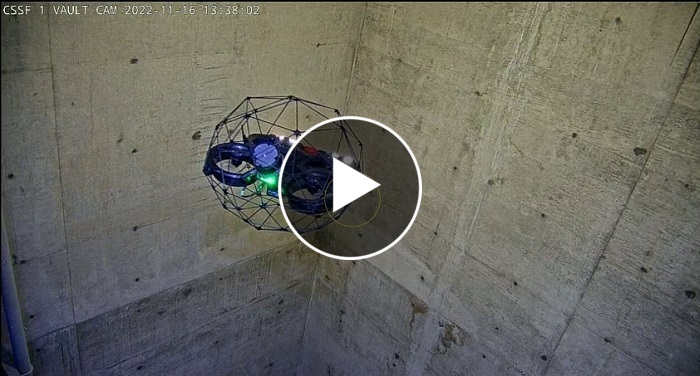 Watch this video on EM's successful drone mission within a high-level radioactive waste storage vault at the Idaho National Laboratory Site — believed to be a world first.
IDAHO FALLS, Idaho – An EM project at the Idaho National Laboratory Site successfully obtained important mapping and radiological data in what is believed to be the world’s first piloted drone mission inside a high-level radioactive waste storage vault.
Calcine Retrieval Project (CRP) engineers with EM contractor Idaho Environmental Coalition (IEC) successfully flew two missions inside a calcine bin set at the Idaho Nuclear Technology and Engineering Center (INTEC) to provide the most detailed map of its interior since it was constructed in the early 1960s. Engineers were pleased with the results because the data will help the CRP advance its mission.
“Getting this data was crucial to the project safely moving forward,” said CRP engineer Kevin Young. “The mission was a huge success.”
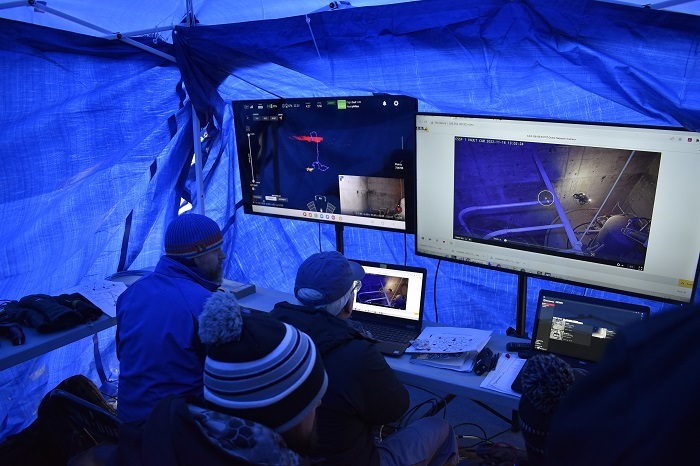 The Calcine Retrieval Project team conducts drone piloting operations from a temporary shelter at the Idaho National Laboratory Site.
The CRP is developing equipment to retrieve and transfer 220 cubic meters of granulated high-level radioactive waste called calcine from one bin set to another. The emptied bin set would then be closed under federal regulations. Ultimately, all 4,400 cubic meters of calcine from six bin sets must be retrieved, packaged and ready for shipment out of Idaho by 2035 in compliance with the 1995 Idaho Settlement Agreement.
Calcine is a dried byproduct of liquid waste generated during historic spent nuclear fuel reprocessing runs at INTEC until 1992. Heat was used to evaporate the liquid, leaving a granular material resembling dried laundry detergent. It was then transferred by compressed air into six concrete bin sets that resemble silos in later designs.
During the vault entries, the pilot flew the drone in a planned flight pattern near the four bins that make up the set to get the most accurate representation possible. In the second mission, engineers used the drone to get radiation measurements inside the concrete vault.
The three-dimensional data obtained by the drone’s equipment will allow CRP engineers to accurately plan where to position retrieval equipment as it enters the four cylindrical bins that house calcine.
“There were months of preparation for these flights,” said Young. “This effort was only made possible by several organizations and individuals who operated as a strategic team to complete this mission.”
-Contributor: Erik Simpson
 Janelle Armijo with the EM Carlsbad Field Office explains how the New Filter Building, which is part of the Safety Significant Confinement Ventilation System, will tie into the existing ventilation system at the Waste Isolation Pilot Plant during a tour of the site on Dec. 8. EM Senior Advisor William “Ike” White and Associate Principal Deputy Assistant Secretary for Field Operations Nicole Nelson-Jean are pictured facing Armijo in the foreground.
EM Senior Advisor William “Ike” White and Associate Principal Deputy Assistant Secretary for Field Operations Nicole Nelson-Jean last week visited the Waste Isolation Pilot Plant (WIPP), where they received briefings on key projects, and met with stakeholders and elected officials in southeast and northern New Mexico.
While their schedule was full, the trip provided a timely update on EM progress in the state.
"While the New Mexico trip was a quick one, it was quite helpful as EM looks forward to closing out a successful 2022 in New Mexico and making more progress in the coming year," White said. "In 2022, EM made a concerted effort to increase stakeholder engagement by EM-Los Alamos and WIPP and we plan to increase our efforts in 2023.”
On the first day, White and Nelson-Jean met with Hobbs Mayor Sam Cobb, who highlighted areas where the City of Hobbs is working with WIPP to ensure the site’s continued success. Cobb also discussed opportunities for increased coordination between Hobbs and DOE.
The next day, the EM leaders met with local elected and community officials in Carlsbad to discuss WIPP and EM’s community involvement. That included a meeting to discuss WIPP operations with Carlsbad Mayor Dale Janway, Carlsbad Nuclear Task Force Chairman Jack Volpato and former state representative John Heaton.
"Our trip helped reinforce that New Mexico remains an environmental cleanup priority for EM," Nelson-Jean said. "We are eager to continue working with elected officials, community leaders and regulators throughout New Mexico to help ensure the success of EM’s mission."
Additionally, White and Nelson-Jean toured the Southeastern New Mexico College with Monty Harris, the college’s interim chief academic officer provost. Recently, DOE committed to work with the college on how to apply for a workforce pipeline grant. During the tour, the EM leaders learned how the grant money will benefit the local college and workforce development.
At WIPP, White and Nelson-Jean viewed progress on two large capital projects currently underway: the Safety Significant Confinement Ventilation System and a new utility shaft, which will increase the overall airflow provided to the WIPP underground. Read about those projects in a separate story in this EM Update issue. They also toured the WIPP underground disposal area, including Panel 8, the newly mined disposal area for transuranic waste.
In the WIPP underground, the EM leaders participated in a small ceremony to recognize the work and advocacy of Heaton, who has supported WIPP for many decades. White presented Heaton with a letter of gratitude from Energy Secretary Jennifer Granholm and two challenge coins, one from Granholm and one from EM.
Next, the group traveled to Santa Fe to meet with local leaders and regulators. White and Nelson-Jean met with Santa Fe County Commissioner Anna Hansen and State Rep. Christine Chandler.
White and Nelson-Jean also discussed areas of shared cooperation and interest with New Mexico Environmental Department Secretary James Kenney and some of his staff members. The discussion offered valuable insight from New Mexico’s top regulator on EM cleanup operations. White, Nelson-Jean and Kenney also focused on how DOE and New Mexico can work together more closely to achieve common goals and ensure cleanup operations in southern and northern New Mexico continue to be conducted safely, transparently and efficiently.
These interactions with local leaders and state regulators follow recent public engagement meetings held by the WIPP team in Santa Fe and ongoing meetings on the EM-Los Alamos 10-year vision. EM remains committed to working with its stakeholders and officials to instill continued commitment of the environmental cleanup mission in New Mexico.
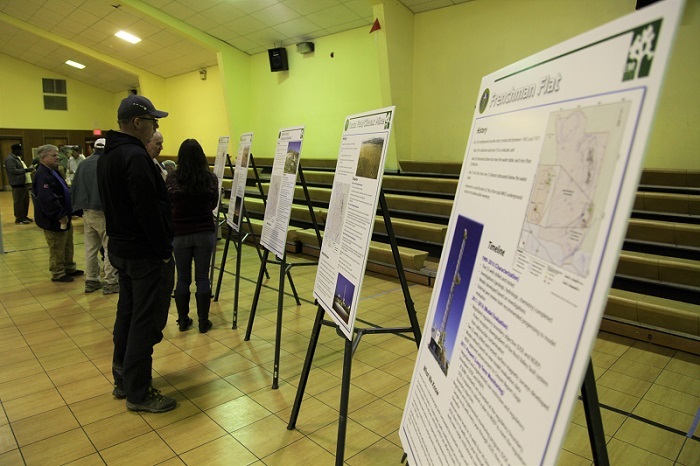 Amargosa Valley, Nevada visitors view displays at the EM Nevada Program Groundwater Open House.
AMARGOSA VALLEY, Nev. – Trevor Dolby attended the EM Nevada Program Groundwater Open House here last month to learn more about the quality of the water in his rural community.
Water, after all, is arguably the most important issue facing this small town of slightly more than 1,000 in the desert some 90 miles northwest of Las Vegas.
“Everybody out here is on groundwater and almost everybody is on a private well,” said Dolby. “The industry we have here is dairy and alfalfa. And, to support the dairy, that takes a lot of water.”
On this particular night during the open house at the Amargosa Valley Community Center, Dolby and dozens of other community residents talked with scientists from the EM Nevada Program and other organizations.
They discussed extensive testing that has been done on groundwater at the nearby Nevada National Security Site (NNSS), which was the scene of underground nuclear testing for decades until the early 1990s.
Residents learned that extensive analysis of the groundwater in the region shows the groundwater in Amargosa Valley is free of contaminants like tritium that resulted from the nuclear testing, and that there is no expectation of future contamination.
“We have confidence (in the water quality), plus most of the people here get that,” Dolby said.
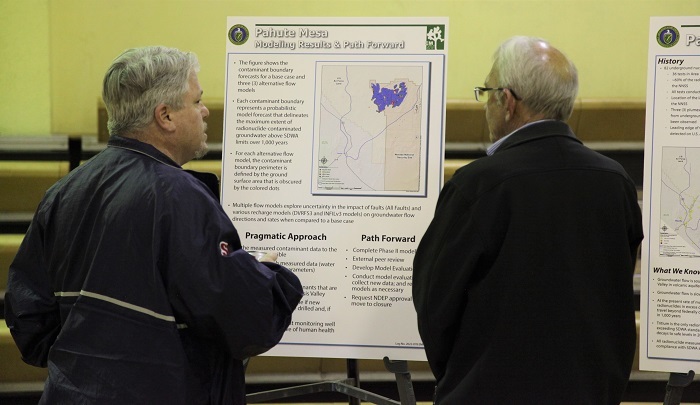 EM Deputy Program Manager Bill Wilborn, left, talks with a resident during the Groundwater Open House.
Federal, state of Nevada, and Nye County representatives along with EM Nevada contractors were on hand to answer questions and engage with the public. Open house participants were able to talk about topics such as computer modeling, hydrology and groundwater sampling at over 100 wells across the NNSS and surrounding federal lands. EM Nevada highlighted additional groundwater monitoring activities.
“Attendees gained insight into our mission progress, latest modeling and sampling data, and learned about the work we do to ensure the safety and security of communities near the NNSS,” said Robert Boehlecke, EM Nevada program manager.
In addition, the event featured displays, posters and videos detailing the intensive work being done to understand groundwater affected by historic underground nuclear testing. Three of four main groundwater regions at the NNSS have been successfully transitioned into long-term monitoring with only the Pahute Mesa groundwater area remaining. The program draws from more than 60 years of data collection to inform its models and projections.
“I was interested in the tritium and if there is any new data on whether tritium is leaking off the test site,” said Amargosa Valley resident George Tucker. “Obviously there isn’t (any leakage). I was adequately impressed.”
EM Nevada Program contractor Navarro Research & Engineering Environmental Scientist Irene Farnham said she fielded many questions from inquisitive local residents.
“The open house provided a great opportunity to let the people of the communities near the Nevada National Security Site know that they are important to us as scientists and that we are working hard to ensure that their drinking water is safe and will be safe for many years to come,” Farnham said.
Beverly Parker is a Community Environmental Monitoring Program project director for the Desert Research Institute. She talked to multiple attendees about the federally funded program that works to protect the environment.
“The event was wonderful,” Parker said.
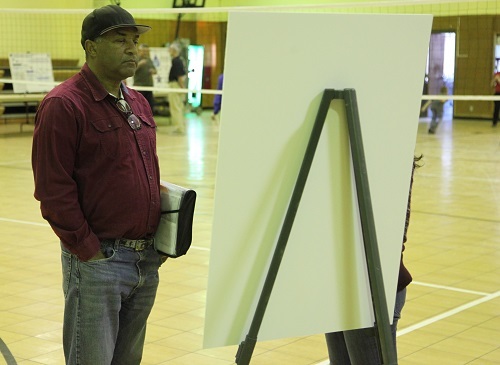 |
|
An attendee reads a display at the Groundwater Open House.
|
This was the ninth Groundwater Open House with a nearly three-year hiatus caused by the COVID-19 pandemic. The event was most recently held in Beatty, Nevada in 2019.
In late October, Navarro Hydrogeologist Jeff Wurtz made a related presentation to middle school students at Amargosa Valley School. Over 50 students packed the classroom to hear Wurtz explain the water table and groundwater system. He also discussed the history of the NNSS and EM Nevada’s mission to characterize the groundwater system and establish a long-term monitoring network on and around the site.
Wurtz also demonstrated a dynamic model resembling an ant farm to illustrate a cross section of water movement underground and how contamination travels in different settings. Watch this video for more about the demonstration.
“Being able to present to students in person and seeing their eyes light up using the model is energizing,” said Wurtz. “These young folks today asked excellent questions and it is encouraging to see their levels of understanding. The use of the model helps reinforce and expand that knowledge.”
-Contributor: Glenn Puit
 Construction on the Safety Significant Confinement Ventilation System at the Waste Isolation Pilot Plant continues to progress, including excavation for tanks and piping, as seen here outside of the Salt Reduction Building recently.
CARLSBAD, N.M. – One is very visible, and one you can’t really see. But both capital projects at EM’s Waste Isolation Pilot Plant (WIPP) are making remarkable progress due to a determined, creative workforce that is overcoming the challenges of the multimillion-dollar work so the facility can operate safely and compliantly for decades to come.
“WIPP’s utility shaft and the Safety Significant Confinement Ventilation System (SSCVS) are making very good progress and are overcoming supply chain issues with creative workarounds,” said Steve Smith, capital and infrastructure projects manager with WIPP management and operations contractor Nuclear Waste Partnership (NWP).
The shaft will be an air intake for the massive SSCVS being constructed. It is WIPP’s fifth shaft — there are also salt, waste, air intake and exhaust shafts — and upon completion, the utility shaft will be the site’s largest at 26 feet in finished diameter.
The utility shaft will provide air into the mine, including mining on new panels to the west of the WIPP facility. The SSCVS will increase airflow in the underground from 170,000 to 540,000 cubic feet per minute, providing enough airflow to simultaneously mine, emplace waste and bolt. Bolting controls the movement of salt rock — known as salt creep — in the WIPP underground.
Since the post-COVID recommencement of excavating at the utility shaft in June, crews have worked around the clock to reach 720 feet — en route to the final shaft depth of 2,275 feet. The shaft is lined with concrete to 712 feet.
Debris is blasted one-half layer at a time; as of Nov. 30, 134 blasts have loosened enough rock for 2,285 buckets of muck to be removed to the surface. Muck is currently being hauled east across the WIPP access road to a salt pile north of the site. The New Mexico Environment Department recently approved the use of a new salt pile on the west side of the road.
On order are two air intake fans — which will generate 520,000 cubic feet per minute of airflow, forcing air down the shaft and into the WIPP underground — along with battery packs for a hybrid bolter and a continuous mining machine.
“The utility shaft is tracking to the schedule, progressing through some of the most difficult geology now and still maintaining the overall project schedule,” Smith said. “Though you can’t see it, as it is all subsurface, excellent progress is being made.”
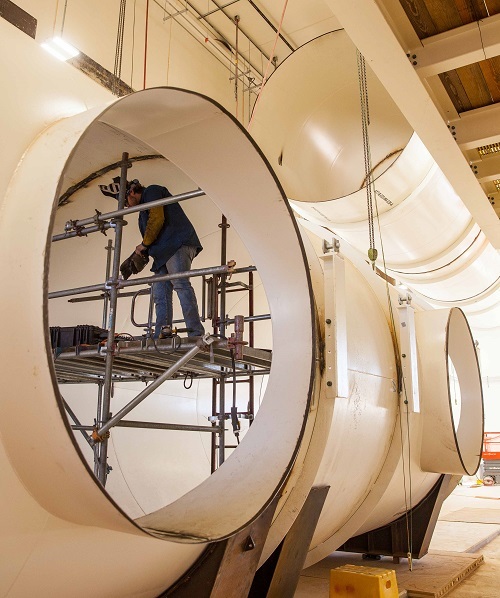 |
|
As part of the Safety Significant Confinement Ventilation System, this Salt Reduction Building (SRB) ductwork will connect to fans that will move air from the underground to the New Filter Building after removing salt. The ductwork is now connected to the ceiling of the SRB.
|
More visible is construction on the SSCVS, which consists of two buildings, the Salt Reduction Building (SRB) and the New Filter Building (NFB).
The SRB will use demisters and other equipment to drop salt from the underground airflow as it reaches the surface.
Fans will then move the air to the NFB, where 1,000-horsepower fans, already onsite, will pull the air through 22 high-efficiency particulate air (HEPA) filter banks before exhausting the air through a 125-foot stack. The switchable filter banks mean work in the WIPP underground will not have to slow during filter changes.
At the NFB, workers have finished installing columns and roof beams, and most wall panels. At the SRB, crews completed the HVAC ducting; main airflow ductwork; and a weather-tight, multi-layer, multi-material roof.
“Anyone can look at the SSCVS project and see the structures are erected and the majority of the Salt Reduction Building equipment is installed,” Smith said.
-Contributor: Roy Neese
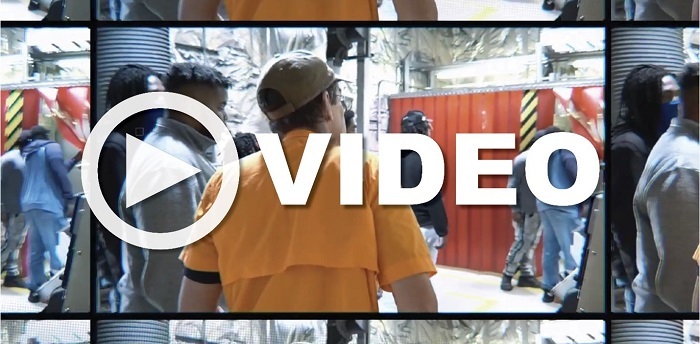 Watch this video on Denmark Technical College’s welding program visit to the Savannah River Site.
AIKEN, S.C. – EM's Savannah River Site (SRS) liquid waste contractor has forged a partnership with South Carolina's only historically black technical college to help prepare the next generation of welders.
Students and faculty of Denmark Technical College's (DTC) welding program recently toured Savannah River Mission Completion’s (SRMC) welding facilities. DTC then hosted an SRMC welding inspector at the school to speak to students and faculty in the welding program. These tours are a result of a memorandum of understanding (MOU) signed between the organizations in July.
SRMC hosted welding program instructors and students at the welding shop in the H Tank Farm, which is a grouping of large underground waste-storage tanks at SRS. The welding shop is where all welders must be tested and certified before starting work for the Liquid Waste Program at SRS.
This onsite tour provided students the opportunity to learn more about job opportunities within SRMC, as well as networking opportunities with leadership such as SRMC President and Program Manager Dave Olson, SRMC Project and Construction Director Brandon Witt and SRMC Welding Engineer Randy Rimes.
According to Olson, the MOU is an important part of SRMC’s community commitment to regional education outreach.
“The partnership between Denmark Technical College and Savannah River Mission Completion benefits both organizations,” Olson said. “DTC students are able to gain real-world experience through internships supporting SRMC’s welding facility.”
During his visit to DTC’s welding facility, Rimes reviewed curriculum with faculty, discussed opportunities for internships and jobs with students and examined the school’s equipment to ensure the students are working on equipment that would help them at SRS.
“After more than 30 years in this trade, I’m more than happy to pass on any knowledge I can to students considering pursuing welding,” Rimes said. “Working at the Savannah River Site is a great opportunity for any early-career welder. There is a lot to be learned from the way we work.”
The MOU between SRMC and DTC is effective until June 30, 2023, and can be renewed.
-Contributor: Lindsey Kennedy
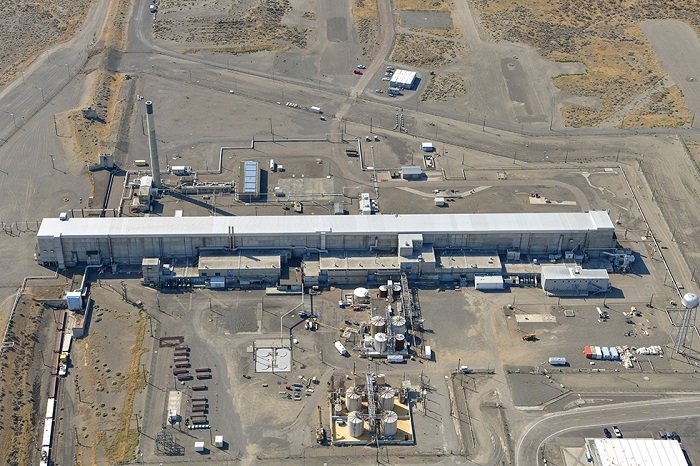 An aerial view of the Plutonium Uranium Extraction Plant. The main facility is at center. Also shown is the 211-A Chemical Storage Area, which is the open area just below the main facility, and the 203-A Acid Storage Area, which is the open area in foreground.
RICHLAND, Wash. – Crews with EM Richland Operations Office (RL) contractor Central Plateau Cleanup Company (CPCCo) are performing risk-reduction activities to prepare a former plutonium processing facility on the Hanford Site for eventual disposition.
The Plutonium Uranium Extraction Plant (PUREX) was the final and most advanced chemical separations plant on the site.
Cleanup is currently focused on the north side of the main PUREX facility, where crews are preparing the 211-A Chemical Storage Area and 203-A Acid Storage Area for equipment removal and demolition. Both areas contain chemical storage tanks, structures and equipment that supported operations.
“It will be a yearslong effort to get this large facility ready for disposition, and I’m encouraged by the progress to safely and efficiently advance this work,” said Andy Wiborg, RL Projects and Facilities Division team lead for Hanford’s Central Plateau Cleanup Project.
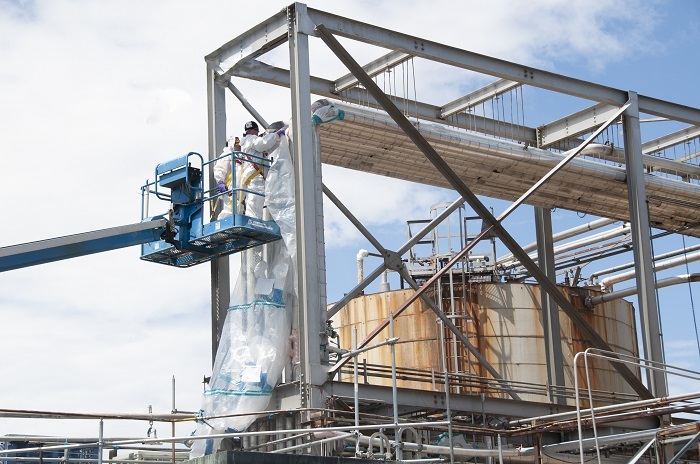 Crews at the Plutonium Uranium Extraction Plant install bags on a piping system to safely remove asbestos-containing material in the 203-A Acid Storage Area.
PUREX was key to Hanford’s plutonium production mission during the Cold War era. Nearly 70% of Hanford’s irradiated fuel rods were processed through PUREX, which was designed to recover plutonium from the uranium fuel.
The 211-A Area contains 20 chemical storage tanks. Eight small tanks are located inside a pump house. Crews recently began draining chemical lines inside the pump house to prepare for eventual demolition. The lines were flushed during the 1990s, but workers needed to confirm no process fluids remained. Workers also inspected and sampled inside tanks that had not been opened in decades, ensuring workers will be able to safely demolish them in coming months.
Workers have also been making progress cleaning up asbestos at the 203-A Acid Storage Area. Constructed in 1954, the 203-A Area consists of a pump house, a railroad loading dock and a secondary containment area that housed nine aboveground tanks. So far, crews have removed asbestos-contaminated insulation from nearly 1,600 of 1,900 feet of pipeline in the 203-A Area.
“Our crews are making excellent progress on a daily basis,” said Darin Corriell, CPCCo PUREX manager. “We have a team of highly skilled professionals who are focused on taking things step by step to ensure a safe, effective cleanup.”
-Contributor: Mark McKenna

The U.S. Department of Interior (DOI) recently announced 18 communities across the U.S. as World War II (WWII) Heritage Cities, including four communities with sites important to DOE.
The National Park Service (NPS), part of the DOI, oversees the American World War II Heritage Cities Program, which recognizes contributions citizens in counties, towns and cities made to support America’s WWII effort.
The four communities and DOE sites are:
All of these DOE sites have ongoing EM cleanup work.
In a 2021 letter to NPS supporting Los Alamos County’s inclusion in the WWII Heritage Cities Program, U.S. Sen. Ben Ray Luján wrote, “Los Alamos is famed for their work in creating the atomic bomb during World War II, and has since done a remarkable job of preserving this history and creating a living legacy of continued scientific innovation.”
The WWII effort in the U.S. saw most men and women do their part to support American and other troops in the Allied countries in the massive effort to defeat the Axis countries, primarily Nazi Germany, Imperial Japan and Fascist Italy. The U.S. industrial effort helped win the war by equipping millions of troops with the uniforms, weapons, ordnances, vehicles, planes, ships and other items critical to the war effort.
According to historian and retired Army Lt. Col. Thomas D. Morgan, before WWII, the U.S. Army totaled less than 200,000 men and was ranked 17th in the world among armies by force numbers, with obsolete aircraft and other equipment. This puts the efforts of the WWII Heritage Cities into greater perspective, showing how men and women on the home front joined the military, or went to work producing large quantities of war material.
The WWII Heritage Cities Program was established by Congress, “to recognize the historic importance of the United States domestic involvement in World War II and ensure the continued preservation of a defining period in American history.”
|
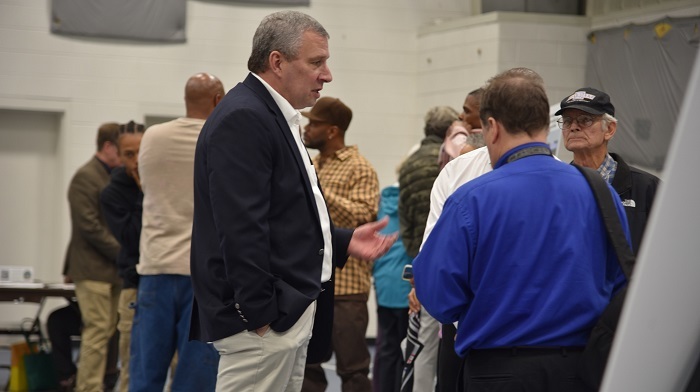 Oak Ridge Office of Environmental Management Regulatory Specialist Roger Petrie, left, answers questions and shares details about the Environmental Management Disposal Facility project to attendees of a public information session on Dec. 8.
OAK RIDGE, Tenn. – DOE Oak Ridge Office of Environmental Management (OREM) officials reached an important milestone this fall in preparing for a new onsite disposal facility by signing a record of decision with the U.S. Environmental Protection Agency and Tennessee Department of Environment and Conservation.
The recently signed document allows OREM and its contractor UCOR to move forward with a final design for the facility and begin activities to prepare for its construction.
The Environmental Management Disposal Facility (EMDF) is key to providing the waste disposal capacity needed to continue cleanup efforts at the Y-12 National Security Complex and Oak Ridge National Laboratory. OREM’s current waste disposal facility is at 83% capacity.
While all high-level radioactive waste is shipped out of state for disposal, OREM needs the new onsite disposal facility for low-level waste, such as soil and building rubble, generated from cleanup projects.
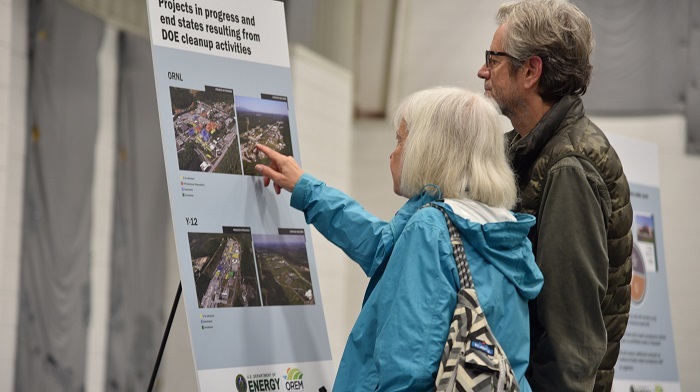 Community members attending a Dec. 8 public information session learned about the next phase of the Environmental Management Disposal Facility (EMDF) project, upcoming site preparation activities and the Groundwater Field Demonstration project, which will help the Oak Ridge Office of Environmental Management and regulators understand how groundwater well levels adjust, informing the final EMDF design.
As the EMDF project enters a new phase following the record of decision, OREM is maintaining its commitment to keep the community informed about the project as it progresses. OREM hosted an information session last week as the most recent effort to continue public outreach.
The two-hour open house style event on Dec. 8 featured posters with new information on the next phase of the project, upcoming site preparation activities and the Groundwater Field Demonstration project. That study will help OREM and regulators understand how groundwater well levels adjust, informing the final EMDF design.
Site preparation activities, scheduled to begin in summer 2023, will involve moving roads and utilities and developing an area to support future construction crews. The Groundwater Field Demonstration project is expected to begin late next year.
Top subject matter experts from the project were on hand at the Dec. 8 event to discuss updates and answer questions from attendees.
“There are still a lot of questions the public has,” said OREM Regulatory Affairs Specialist Roger Petrie. “We know more questions would arise as we proceeded, so we want to have these public meetings to address as many of those as possible.”
OREM will continue sharing the latest developments about the project at the next information session scheduled for next summer.
The Dec. 8 event follows two public comment periods, formal meetings, information sessions and numerous presentations since 2018.
More information about the EMDF project is available here.
-Contributor: Ben Williams
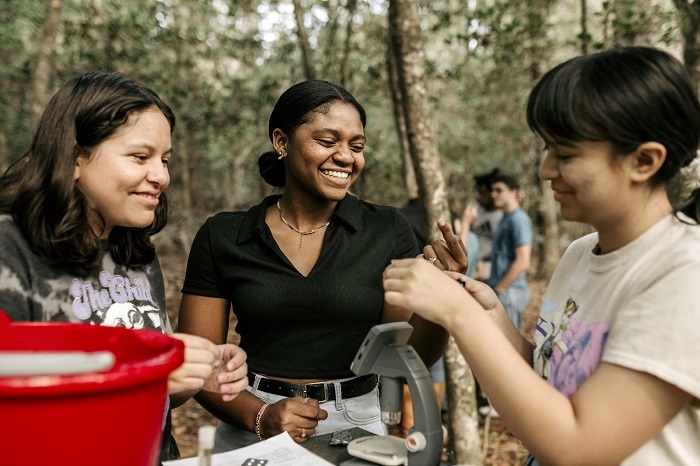 From left, South Aiken High School students Alexa Duran-Figueroa, Ashleigh Fair and Damaris Guillen examine aquatic organisms captured in a nearby streambed at Savannah River Site.
AIKEN, S.C. – Unique field trips for teachers and students alike that focus on environmental science in the vast forests of Savannah River Site (SRS) are up and running again after COVID-19 shut them down in 2020.
The tours are part of the Science and Technology Enrichment Program (STEP), one of the most popular education outreach initiatives at SRS. Visitors take part in real-time and virtual field trips in what became the first national environmental research park in 1972. That area at the 300-square-mile SRS is home to rare endangered species including wood storks, bald eagles and re-cockaded woodpeckers, as well as wild turkeys, white-tailed deer and otters.
Managed by EM contractor Savannah River Nuclear Solutions (SRNS), STEP is a cooperative effort between SRNS and the Ruth Patrick Science Education Center with special assistance from the University of Georgia’s Savannah River Ecology Laboratory.
“The STEP Field Trip Program provides opportunities for local educators to bring students to the Savannah River Site,” said Taylor Rice with SRNS Education Outreach. “These outdoor settings at SRS enhance STEM-based education by providing a practical application to enhance environmental science.”
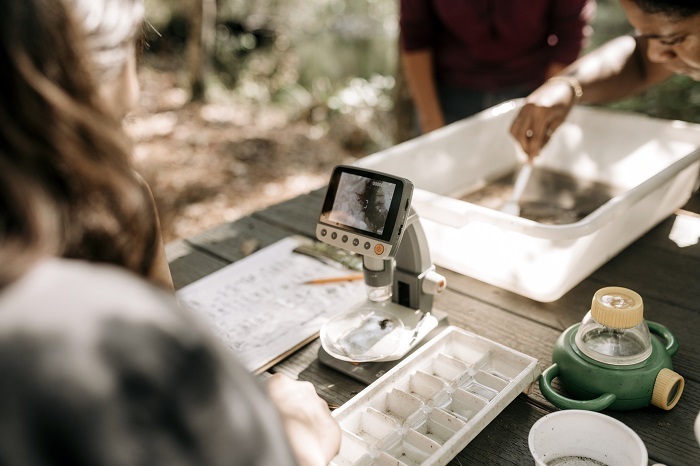 South Aiken High School students view aquatic organisms under a microscope as they learn about nature through the Savannah River Nuclear Solutions Science and Technology Enrichment Program at Savannah River Site.
STEP lessons correlate to academic science, technology, engineering and mathematics (STEM) standards for grades three through 12. Lessons use real-world investigations that focus on responsible environmental stewardship.
The lessons have focused on preserving the nesting habitat of the endangered red-cockaded woodpecker and identifying freshwater macroinvertebrates in ponds and streams, among other topics.
During a recent in-person STEP visit, South Aiken High School students searched a small stream for aquatic invertebrates, which are critical to a healthy forest’s food chain. They temporarily caught and studied creatures such as the damselfly, water scorpion and leech.
“The value of this program is immeasurable,” said Jamie Hatchett, South Aiken High School science teacher. “For our students to be able to come out here and get hands-on, real-world experience with what we’re talking about in the classroom is an incredible resource.”
-Contributor: DT Townsend
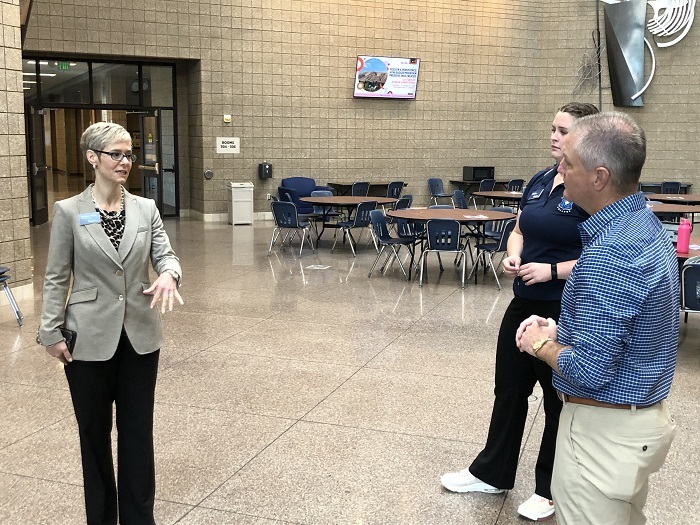 Columbia Basin College President Rebekah Woods, left, and student ambassador Megan Holm, center, lead Washington River Protection Solutions President and Project Manager Wes Bryan on a tour of the college campus in Pasco, Washington.
RICHLAND, Wash. – Adding to the growing list of cooperative, or co-op, programs with colleges and universities, EM Office of River Protection (ORP) contractor Washington River Protection Solutions (WRPS) has launched a new pathway to jobs on the Hanford Site.
The goal is to prepare the next generation of Hanford Site workers to replace retirees. WRPS worked with Columbia Basin College (CBC), a local community college that offers two- and four-year degree programs, to provide paid internships in chosen career fields, including everything from project management and information technology to engineering and human resources.
“Students who apply to the program need to have a minimum 2.0 grade point average and must be enrolled full time in a bachelor’s or associate degree program at CBC,” said Amy Hayfield, manager of Workforce Resources at WRPS. “We’re excited to welcome our first round of interns at the beginning of the new year.”
 |
|
Career Services team members at Columbia Basin College talk with a student at a recent event to recruit students for the Pathways to Hanford program, a customized program that brings awareness to degrees, certifications and internship programs that provide training for jobs at the Hanford Site. Photo courtesy of Columbia Basin College.
|
|
Washington River Protection Solutions Workforce Resources Manager Amy Hayfield speaks to a group of students in July taking part in summer and cooperative internships.
|
|
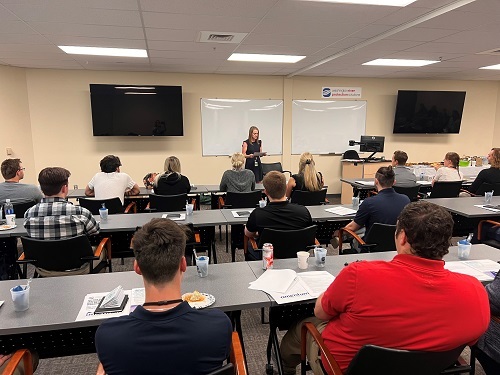 |
Co-op interns will work at least 20 hours a week while completing their educations, with the potential to work full-time hours in the summer. The internships could lead to full-time employment when they graduate.
“This is the future of workforce development,” said Delmar Noyes, ORP assistant manager for Tank Farms. “Integrating a new generation of employees that can learn from the current workforce is vital for complex missions like those at the Hanford Site.”
CBC offers project management, nuclear technology and occupational health and safety certificate and degree programs tailored to meet EM’s needs at the site.
“Our students recognize this unique opportunity to kick-start a career while completing their degrees,” said Elie Hernandez, director of Career Services at CBC.
The CBC internship co-op is patterned after a similar program WRPS established with Washington State University’s campus in Richland. The first students from that internship started working over the summer and a few co-op interns have already accepted full-time jobs with WRPS.
-Contributor: Jenna Kochenauer
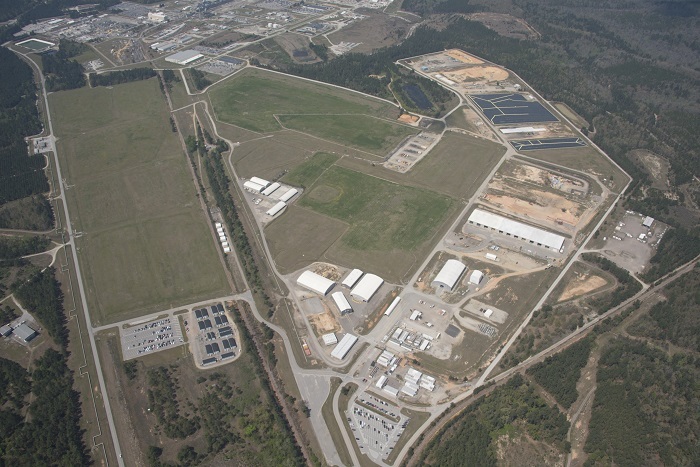 The Solid Waste Management Facility at the Savannah River Site.
AIKEN, S.C. – Contractor employees recently implemented a new web-based waste tracking system to reduce risk of database failures and better serve the needs of the Savannah River Site (SRS).
The Consolidated Waste Tracking System (CWTS) replaces several different waste tracking systems used at SRS over the past 20 years.
“This was a huge undertaking and is the culmination of four years of detailed planning, development and rigorous testing,” said Verne Mooneyhan, manager of the Solid Waste Management Facility for the site’s managing and operating contractor Savannah River Nuclear Solutions (SRNS).
The new system helps SRS track, forecast, receive and dispose transuranic, low-level, hazardous and mixed waste more efficiently while better maintaining waste characterization data and performance of limit checks to ensure waste items do not exceed prescribed limits.
“As a result, these functions are performed with less risk of failure than past tracking systems,” Mooneyhan said.
Implementation of CWTS took place in three phases, an effort involving departments from across SRNS.
“We are pleased to see CWTS implemented,” said SRNS President and CEO Stuart MacVean. “SRNS employees are always looking for ways to reduce risks and improve performance. CWTS will serve SRS well now, and for many years to come.”
-Contributor: Lindsey MonBarren
 From left, Four Rivers Nuclear Partnership Community Relations Specialist Steve Christmas; Heath Middle School (HMS) students Sam Dobson, Gavin Schooley and Caroline Roberts; HMS Science Bowl Coach Brandy Roberts; and EM Portsmouth/Paducah Project Office Site Program Analyst Robert “Buz” Smith pose with a $1,000 check awarded to HMS for the students’ winning design for the 2023 DOE West Kentucky Regional Science Bowl t-shirt contest.
PADUCAH, Ky. – Three eighth graders from Heath Middle School (HMS) won this year’s DOE West Kentucky Regional Science Bowl t-shirt design contest.
Sam Dobson, Caroline Roberts and Gavin Schooley collaborated on a design selected as this year’s official event t-shirt.
“Each year I am impressed with the many student t-shirt design concepts entered and the excitement our students demonstrate during the academic competition,” EM Portsmouth/Paducah Project Office (PPPO) Manager Joel Bradburne said. “The DOE West Kentucky Regional Science Bowl allows our students to showcase their scientific prowess and help expand their knowledge in a variety of scientific disciplines. We are proud to celebrate the 15th year of this great Paducah event.”
In September, PPPO challenged local middle and high school students to design the event’s official t-shirt, which will be given to students and coaches to wear at the 2023 academic competition. HMS received $1,000 for their students’ winning design.
“It’s a joy to work all year with my team and see how they grow and challenge each other to become better. This year, I am blessed to have a team that is very supportive of each other. They are so cooperative, hardworking, and as evidenced by their winning t-shirt design, they are also a very creative group,” Roberts said. “I am so thankful to DOE and all the contractors who volunteer their time each year to make the Science Bowl an engaging day of competition for all the area students.”
 |
|
Heath Middle School students’ winning t-shirt design for the 2023 DOE West Kentucky Regional Science Bowl.
|
While Dobson, Roberts and Schooley are passionate about science, it was a national sporting event that inspired their design.
“When we saw this was the 15th anniversary of the Science Bowl, it reminded us of the Super Bowl’s iconic Roman numerals,” Roberts said. “We decided it would be exciting to theme our shirts after that.”
High school students will compete in the annual academic competition on Feb. 3 while middle school students will compete on Feb. 10. This year’s competition will be conducted in-person for the first time since 2020. Students, coaches and volunteers are looking forward to the face-to-face interaction.
“I am excited to have the opportunity to compete face to face instead of not being able to see (other teams) because of COVID,” Schooley said.
This is the sixth year for the t-shirt design contest and the 15th year for the Science Bowl competition. The event attracts dozens of schools and more than 100 regional students to compete for the opportunity to advance to the national level.
-Contributor: Dylan Nichols, Jessica Vasseur
|